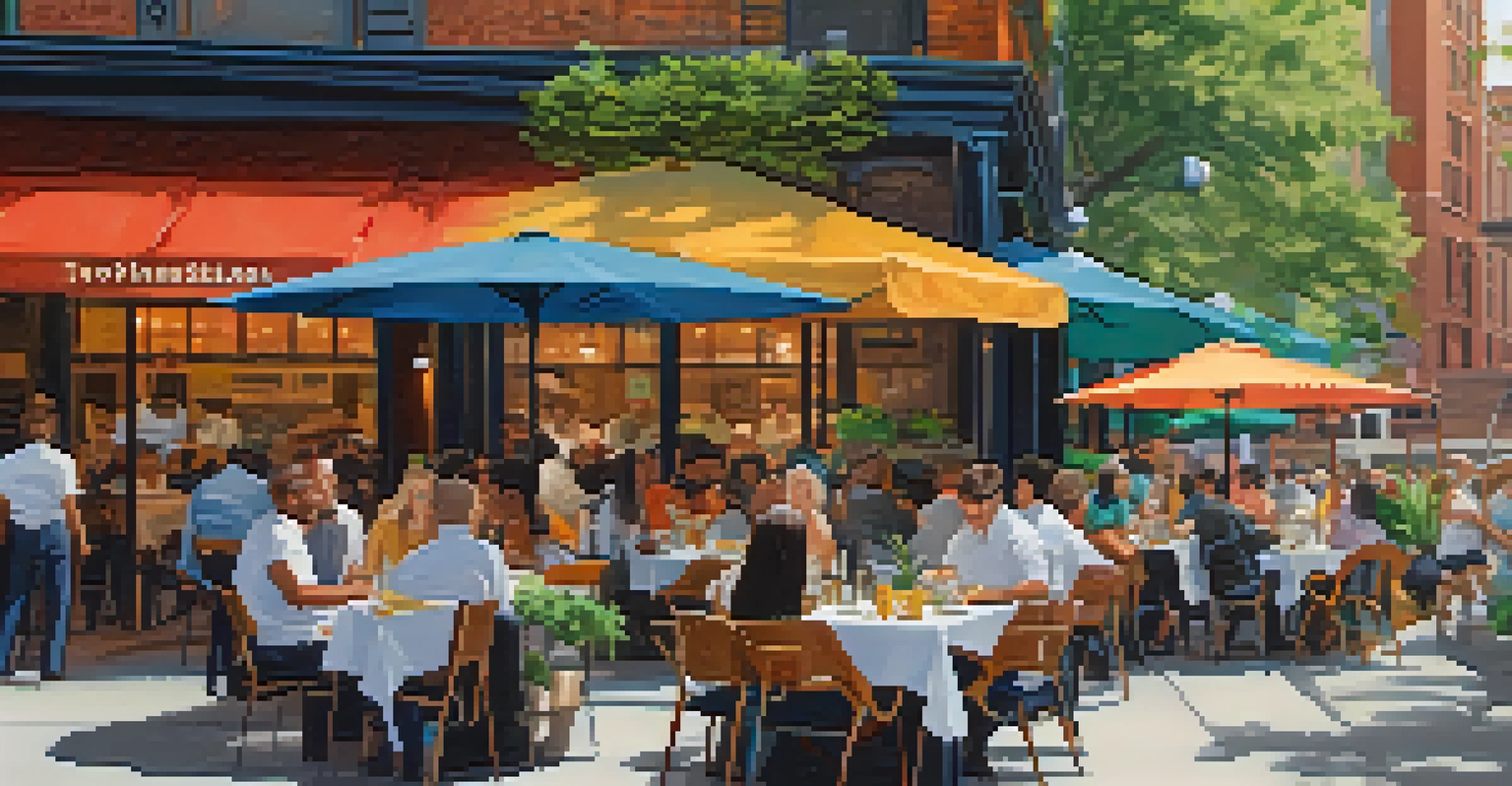COVID-19's Lasting Impact on NYC's Economic Landscape

Overview of COVID-19's Initial Economic Shock to NYC
When COVID-19 hit New York City in early 2020, it sent shockwaves through the economy. Businesses, large and small, faced unprecedented challenges, leading to widespread closures and layoffs. The once-bustling streets of NYC quickly became eerily quiet, reflecting the gravity of the crisis. This initial economic shock was a wake-up call, revealing just how interconnected various sectors are within the city.
In the middle of every difficulty lies opportunity.
From hospitality to retail, NYC’s economic backbone began to crumble under the weight of the pandemic. Restaurants that once thrived on foot traffic suddenly found themselves empty, while hotels stood vacant. The city, known for its vibrant culture and bustling economy, suddenly faced a stark reality, forcing many to adapt or risk permanent closure. It was a moment that tested the resilience of the entire metropolis.
As businesses scrambled to pivot in the face of adversity, the long-term effects of the pandemic began to emerge. The crisis not only disrupted daily operations but also initiated a widespread reevaluation of business models and strategies. This moment of reckoning would shape the future landscape of NYC’s economy in ways that few could have anticipated.
Shifts in Employment and Remote Work Trends
One of the most significant changes brought about by the pandemic was the shift to remote work. As companies quickly adopted telecommuting, the traditional office environment was transformed almost overnight. Many employees found themselves working from home, leading to a reevaluation of work-life balance and productivity. This shift not only affected individual lifestyles but also the broader employment landscape in NYC.

With remote work becoming the norm, companies began to reconsider their need for physical office space. This change sparked conversations around flexible work arrangements and hybrid models, ultimately reshaping how businesses operate. For some sectors, this shift meant a reduction in overhead costs, while for others, it raised questions about company culture and collaboration. The future of work in NYC now looks very different than it did pre-pandemic.
Economic Shock Reshapes NYC
The COVID-19 pandemic caused unprecedented challenges for NYC's economy, leading to widespread business closures and a reevaluation of strategies.
Moreover, this trend has also opened up job opportunities beyond the city’s geographical boundaries. Employers can now hire talent from virtually anywhere, broadening their search for skilled workers. This newfound flexibility has implications not just for the workforce but also for the real estate market, as the demand for office space and housing in NYC continues to evolve.
Impact on Small Businesses and Local Economies
Small businesses, the heart of New York City's economy, faced some of the toughest challenges during the pandemic. Many local shops and restaurants struggled to stay afloat, relying heavily on community support and government assistance. The personal touch that small businesses offer made their struggles feel particularly poignant, as many were forced to close their doors for good. This wave of closures has left a noticeable void in many neighborhoods.
The best way to predict the future is to create it.
However, resilience emerged as small businesses adapted to the new normal. Many pivoted to online sales or expanded their delivery services, finding creative ways to connect with customers. Community initiatives, such as 'Shop Local' campaigns, gained momentum, highlighting the importance of supporting local economies during tough times. This collective effort has not only helped some businesses survive but also fostered a renewed sense of community among NYC residents.
Looking ahead, the survival of small businesses will be crucial for the economic recovery of NYC. As the city continues to rebuild, local entrepreneurs are expected to play a pivotal role in revitalizing neighborhoods, creating jobs, and driving innovation. The lessons learned during the pandemic will likely influence how small businesses operate in the future, emphasizing adaptability and community connection.
Tourism and Hospitality: A New Era
The tourism and hospitality sectors in NYC were among the hardest hit by the pandemic, with travel restrictions leading to a sharp decline in visitors. Iconic landmarks that once welcomed millions stood empty, putting immense pressure on hotels, restaurants, and attractions. The sheer volume of lost revenue highlighted the fragility of these industries, prompting stakeholders to reevaluate their strategies for attracting tourists back to the city.
As restrictions eased, the focus shifted to safety and enhancing the visitor experience. Innovations in health protocols and outdoor dining options became essential for rebuilding consumer confidence. NYC has leveraged its unique offerings, such as open-air markets and cultural events, to entice both locals and tourists alike. This adaptation signifies a shift towards a more resilient and diverse tourism strategy that prioritizes health and safety.
Shift to Remote Work Revolutionizes Jobs
The transition to remote work has transformed employment practices in NYC, prompting companies to rethink their office needs and workforce arrangements.
Moreover, the pandemic has prompted a broader discussion about sustainable tourism practices. As the city rebuilds, there is an opportunity to create a more balanced approach that emphasizes responsible travel and supports local communities. This new era of tourism in NYC could ultimately lead to a more sustainable and equitable hospitality landscape, benefiting both visitors and residents alike.
Changes in Consumer Behavior and Spending Patterns
COVID-19 has undeniably shifted consumer behavior in NYC, with many residents reevaluating their spending habits. As people adjusted to life during the pandemic, there was a notable increase in online shopping and digital services. This sudden shift not only changed how consumers interact with businesses but also forced many retailers to enhance their e-commerce capabilities, leading to a more competitive landscape.
Additionally, the pandemic sparked a growing interest in supporting local businesses, with consumers seeking to invest in their communities. This trend has encouraged more mindful spending and a focus on quality over quantity. As people became more conscious of their purchases, businesses that prioritized sustainability and ethical practices began to thrive. This evolving consumer mindset is likely to have lasting effects on the market.
As NYC moves forward, understanding these changing consumer preferences will be vital for businesses. Companies that can adapt to the new expectations of their customers—whether through improved online experiences or community-focused initiatives—will be better positioned for success. This shift presents both challenges and opportunities, ultimately redefining the retail landscape in the city.
Real Estate Trends in a Post-Pandemic World
The real estate market in NYC has experienced significant fluctuations due to the pandemic. With many people leaving the city in search of more space and affordable living, there was a noticeable dip in demand for rentals and purchases in certain neighborhoods. This shift prompted landlords to rethink their strategies, with many offering incentives to attract tenants back to the city. The dynamic nature of the market has created both challenges and opportunities.
Conversely, some areas have seen a surge in demand as remote work allows individuals to seek out homes that better suit their needs. Suburban and upstate properties have become increasingly appealing, leading to a reevaluation of what 'home' means for many. This trend reflects a broader desire for space, outdoor amenities, and a slower pace of life, which could reshape the urban landscape in the long term.
Small Businesses Drive Community Recovery
Small businesses are crucial to NYC's economic recovery, showcasing resilience through adaptation and community support during tough times.
Looking ahead, NYC's real estate market will likely continue to evolve. Developers and investors will need to adapt to changing preferences, focusing on mixed-use developments and sustainable living solutions. The pandemic has served as a catalyst for innovation in real estate, paving the way for new opportunities that prioritize both functionality and community well-being.
The Future of Workspaces in NYC
As the pandemic has accelerated the evolution of workspaces, NYC is now witnessing a transformation in how companies approach office design and functionality. The traditional open-office layout is being reevaluated as businesses prioritize health and safety. Employers are now considering hybrid models that allow for flexibility, collaboration, and well-being, ensuring that workspaces cater to the diverse needs of employees.
Additionally, there is a growing trend toward creating more adaptable spaces that can accommodate various uses. This includes transforming offices into multifunctional environments that support both in-person collaboration and remote work. Such flexibility not only enhances productivity but also fosters a sense of community and connection among employees, which is vital in today’s work culture.

Ultimately, the future of workspaces in NYC will be defined by a blend of innovation and adaptability. Companies that embrace change and invest in thoughtful workspace design will be better equipped to attract and retain talent. As the city continues to evolve, the workplace will become a reflection of the values and needs of its workforce, paving the way for a more dynamic and inclusive professional landscape.